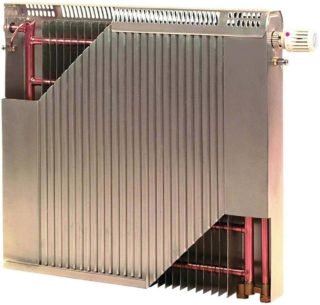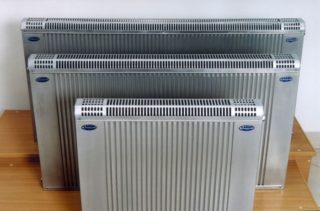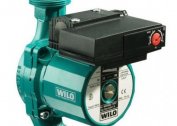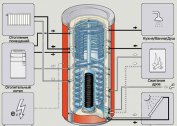The choice of the type of heating devices depends on several factors, including the chemical composition and temperature of the coolant, the scheme of the heating system, and the pressure in it. Composite bimetallic radiators are universal and inexpensive; they are installed under almost any conditions. The cost-conscious owner should be aware of what it is like to choose reliable samples and mount them correctly.
Design features of bimetallic heating appliances
The design of these batteries involves two different metals. Visually, most of them are similar to conventional sectional aluminum radiators. However, premium units can also differ significantly in appearance. In total, the consumer is offered three types of devices:
- sectional (Fe + Al);
- sectional from "semi-metal" (Fe + Al);
- lamellar (Cu + Al).
The most widespread due to the combination of availability, reliability and heat transfer rate was the first option. Outwardly, it is almost impossible to distinguish it from a conventional aluminum battery. Unless with the help of a magnet, by weight (it is heavier than one and a half times) or by looking inside. The main elements transporting the coolant are vertical and horizontal channels made of ordinary or sheathed steel. They are tightly surrounded by an aluminum shell that transfers heat to convection fins.
Devices can be either sectional or monolithic while maintaining the size of the sectional. Monolithic units are more reliable, but much more expensive and do not understand.
“Semimetallic” or “pseudo-bimetallic” devices differ in that the horizontal channels in them are aluminum. Unscrupulous sellers often give out such heating batteries as real bimetallic ones. But these "half-breeds" are inferior to their competitors in their parameters:
- resistance to working and pressure testing, water hammer;
- inertness to atmospheric and electrochemical corrosion.
Copper-aluminum radiators are representatives of the plate type, in which two copper pipes are enclosed in a set of aluminum plates. They are practically devoid of flaws - they are only slightly susceptible to electrochemical corrosion. However, they belong to premium products and are rarely found. Indeed, in this category, as a rule, exquisite cast-iron samples are the leaders in popularity.
Advantages and disadvantages of composite heating appliances
The only obvious drawback of this product is its susceptibility to atmospheric corrosion. In cases of draining water from the heating system or choosing low-quality antifreeze instead, the steel channels rust. Because of this, the smoothness of the walls is violated and the permeability of the pipe is reduced, up to the formation of a cork. It usually doesn’t get through holes. However, more expensive models are sometimes protected from the inside by a special coating.
Electrochemical corrosion is less likely, but possible in the presence of direct or indirect contact of two different metals, for example, in the device itself or in situations where the pipeline is made of copper or "stainless steel". It is also possible electric corrosion that occurs when trying to ground electrical appliances on the elements of the heating system.
Advantages of aluminum-steel bimetal heating radiators:
- resistance to increased working and pressure testing, as well as water hammer, often found in high-rise buildings;
- mechanical strength of steel;
- service life of 20 years;
- comparative inertness of steel to electrochemical and electrical corrosion;
- inertness of aluminum to atmospheric corrosion;
- neat appearance;
- heat transfer;
- availability.
An obvious disadvantage of these units is also the high probability of falsification, for example, attempts to pass pseudo-bimetal to bimetal or simply poor-quality assembly. You can avoid an unsuccessful purchase by following simple guidelines when choosing.
Signs of poor quality and technical parameters of devices
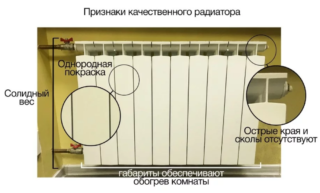 The price of high-quality composite batteries sometimes exceeds 1,500 r. per section. This amount, as a rule, is two to three times the cost of semi-metal or aluminum samples. Since they are easy to confuse outwardly, the prevalence of fakes is not surprising. Most of the signs of this phenomenon can be detected by conducting an elementary examination.
The price of high-quality composite batteries sometimes exceeds 1,500 r. per section. This amount, as a rule, is two to three times the cost of semi-metal or aluminum samples. Since they are easy to confuse outwardly, the prevalence of fakes is not surprising. Most of the signs of this phenomenon can be detected by conducting an elementary examination.
- Inspect the product - chips and dents indicate poor quality shell.
- Shine inside with a flashlight, evaluate the condition of intersectional futory - jams are unacceptable.
- The simplest magnet from the refrigerator, applied to the ends of the channels, will tell about the material of their manufacture.
- A ruler (preferably a caliper) will show the thickness of the channel walls (should be 2.5-3.5 mm), as well as the thickness of the ribs (about 1 mm).
- A good option is to take your scales with you, a section (500 mm) of decent bimetal should weigh at least 1.7 kg, an aggregate of 8 sections should weigh at least 13.5 kg.
- Find out the warranty period - it should not be less than 2 years (better longer).
The area of the fins does not speak about the likelihood of a fake, but about the compliance of the model with its price. An example is sometimes made by Chinese products impersonating Italian or German. High-quality expensive composite radiators cannot have tapering fins and plates that differ in width from each other.
A self-respecting manufacturer will not save on millimeters. If the passport indicates the depth and width of the section 80 mm, it will be so.
Specifications
The characteristics of high-quality bimetallic batteries depend on the category of the model (for example, price), as well as the company and country of manufacture. The exact values of the characteristics are usually indicated in the product passport. However, the range of these numbers is known:
- center distance - 200, 350 or 500 mm (standard common values);
- internal volume of the section - 0.2-0.5 l;
- weight - 1-2 kg;
- working / maximum pressure - 6-15 / 25-100 atm. (monolithic products withstand the greatest pressure);
- maximum heat carrier temperature - 100-130 ° C;
- heat transfer - 110 - 210 W;
- service life - 20-30 years.
Many indicators are interdependent. For example, weight and heat transfer are directly related to the center distance, number and size of ribs. The internal volume also depends on this size, but also on the diameter of the channels.
The main parameters - heating inertness and heat transfer - are significantly affected by the characteristics of the coolant (chemical composition, temperature).
Brand Rating
In Russia, as a rule, products manufactured in Europe (in particular, Italy) enjoy trust. However, do not forget about other producing countries: Ukraine, Russia and China. Domestic and Chinese brands are steadily improving the quality of their products. Nevertheless, European brands have traditionally held primacy in popularity.
- SiraGroup is an Italian company considered to be the ancestor of the manufacture of composite heating appliances. He has been working in his field of activity for over 70 years. Carefully monitors the quality of expensive products.
- Global (Italy) and RoyalThermo (UK-Italy) - occupy an increasingly large market segment due to the combination of quality, reliability and affordability.
- Rifar (Russia) is a popular brand that appeared at the turn of the millennium. Initially, production was carried out under license from Italian manufacturers. Rifar radiators are sharpened under the harsh Russian conditions - climate, water quality, system pressure.
- Titan, Maxterm, Sti (China) are manufacturers widespread in Russia who have earned their good reputation and value it.
ZehjangFlyhigh, WangdaGroup, YongkangJinbau - Chinese companies included in the open "black" list of manufacturers producing low-quality, hazardous to health products.
In addition to the dimensions and the location of the ribs, the products differ in the quality of the metals used. For example, you can often find pseudo-aluminum made from various wastes. Including - radioactive or containing substances harmful to health (asbestos).
Calculation of the number of sections
Sometimes the exact values of the parameters of the heating system and its devices are unknown. In such cases, the number of standard sections is calculated by the formula N = S / 1.8. For a room of 18 m2, 9-10 sections with a center distance of 500 mm will be required. For an accurate calculation, the following data is required:
- area, heat loss of the room;
- heat dissipation of radiators;
- temperature, heat capacity of the coolant.
More or less averaged values:
- Q (heat loss) = 100 W * m2;
- Heat transfer of one section Qc = 180 W / h (at water t = 80-90 ° C).
Thus, the replenishment of heat loss in a room of 18 m2 will require 1800 watts of heat per hour. Given that one section of the bimetal radiator gives 180 watts, they need 10 pcs. However, it must be remembered that modern methods of thermal insulation reduce heat loss at home by three times, compared with average values. Therefore, the dimensions of the devices are significantly reduced.
Features of installing composite radiators
The main nuance of this equipment in terms of installation can be called poor suitability for low-temperature heating systems. Steel is much more inert in heating than aluminum. Therefore, where the coolant temperature is not higher than 50 ° C, soft metal products will be optimal.
In high-rise apartment buildings, composite batteries are the best solution. Here, the temperature is usually not lower than 80, and the pressure (with water hammer) sometimes surpasses 25 atm. However, the recommended installation rules for them are the same as for their competitors (Al):
- placement - in the center of the window;
- height from the floor - 10-20 cm;
- distance to the windowsill - 10-20 cm;
- the distance from the back wall to the wall is not less than 20 mm;
- number of fasteners - not less than three;
- an adjustment valve is placed at the outlet;
- when connecting and supplying water, one must not forget about the air discharge;
- a closed tap on the bypass (jumper) will increase heat transfer, but will harm neighbors.
A good piece of advice is fixing the foil insulation to the wall behind the device, with the foil directed towards it. Given that about a third of the heat is transmitted by infrared radiation, such a trick will increase the efficiency of the unit.
Operation tips
It is practically impossible to influence the duration of the service life and the effectiveness of the bimetal batteries when living in an apartment building. After all, nothing depends on the consumer. But private homeowners are forced to apply various tricks and listen to advice:
- The best heat carrier in all respects is distilled water. In extreme cases - purified softened.
- It is undesirable to use different metals in the heating system - this will increase the likelihood of destruction of its elements from the effects of electrochemical corrosion.
- All units are recommended to be grounded through a full ground loop.
- Recommended pressure in the system is 1.5-2 atm., Temperature - 70-80 ° C.
In the case of the use of non-freezing fluid, do not use one that is made of poisonous ethylene glycol.It is safer and more reliable to fill in a mixture of distilled water and propylene glycol. In any case, the brand of the composition must correspond to that indicated in the passport for the boiler. It is undesirable to use oil and products based on it, because it is much more viscous and inert when heated than water. In addition, burns caused by contact with hot oil are dangerous, and even it is fire hazard.
If the composition of the coolant is different from water, all gaskets, pipes and other non-metallic elements must be oil and petrol resistant.

